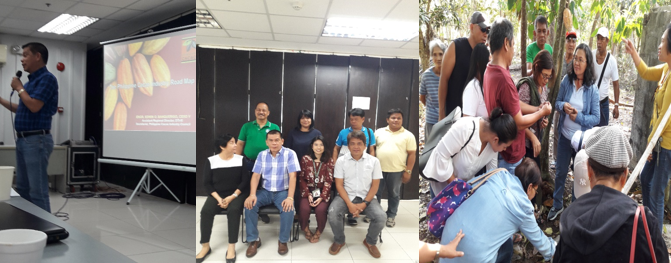The Department of Trade and Industry (DTI) -Region 3 sees bright prospects for cacao as growing interests to plant cacao is visible among farmers and the business community in the region given the huge demands required both by local and export markets as presented by the Philippine Cacao Industry Council (PCIC) during the recently held Cacao Luzon Island Conference held at the main office of the Department of Agriculture.
It is ironic to note that in Region 3, despite the production of cacao, processors still import their requirements from Davao City. This is because the quality of beans produced by farmers in the region does not meet the requirements of the market due to lack of post-harvest facilities for drying and fermentation. Given this, the PCIC has challenged all the Regional Cacao Industry Councils in Luzon to provide support in terms of educating farmers on the right farm management practices in order to attain higher and quality yields.
With the growing demand on cacao beans, there is no other option but to sustain plantation in the countryside to meet the huge market demands. According to statistics shared during the PCIC conference, the Philippines is still a net importer of cocoa products with an import value of US$178,813,154 (Source: PSA), while it is also an exporter of cocoa products. Moreover, the Philippines recorded an increased usage of cacao/chocolate in restaurants and coffee shops and in the food industry in general. With a growing group of artisanal chocolate (“Bean to Bar”) makers, the scenario makes it ideal to grow more cacao. As noted, the key demand growth drivers are: positioning of cacao as a healthy food, product diversification, more of non-food use and improved economic condition.
The Philippines envisions a competitive and sustainable cacao industry where there are more opportunities for Central Luzon stakeholders to grow more cacao. This will maximize the use of idle lands for cacao plantations and other high value crops. Intercropping strategy is one innovations to increase production yields. The challenge to overcome now is how to meet the 100,000 Metric Tons demand of fermented beans by the year 2022. This is for both the export and domestic markets, while there is an annual increase of 40% increase in production. At present, the Philippines has yet to maximize its full capacity production to meet the requirements of the market and this pose a great opportunity for would-be cacao players.
The Regional Cacao Industry Council in Region 3 sets its direction towards the increase of more cacao plantations and ensuring that the right post-harvest facilities are put in place in order to achieve higher yields of quality beans.
To help move the industry in the region, the important role of DA was stressed in the conference, considering that at present under the Philippine National Standards (PNS), cacao is one of the commodity which complies to standards. The Philippine Cacao Roadmap 2018-2022 hopes to achieve the 100,000 MT production target.
Realizing the vast demands for quality cacao beans, Region 3 recognizes the interests of its stakeholders and private sectors. This manifests positive indication that Cacao in the region offers great potential for business.




